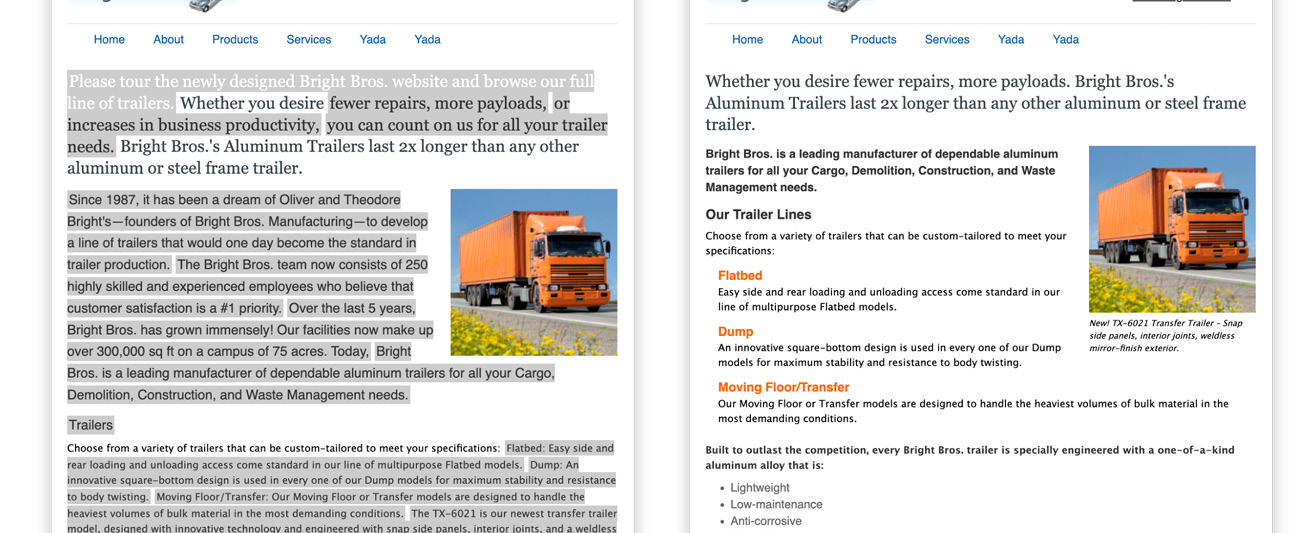
Your website isn’t for you. Sure, the site promotes your propane company. But it’s not for you — it’s for your customers. Your website is a critical touch point for current and potential propane customers. It’s time to embrace a customer-first approach in your website design, ensuring every visitor’s experience is seamless, informative and engaging.
The Customer Comes First — in Real Life & Online
Your personal tone and design preferences can absolutely be included on your website. The focus, though, should always be the customer experience. When someone lands on your website, they’ve already Googled, researched and maybe even visited three other sites. They know what they’re looking for. So, give it to them. Deliver the answers to their questions, put the most important information right in front of them and provide an easy pathway to your services.
Before embarking on a website revamp or redesign, discard any thoughts about what you want or what you think makes sense on your website. Take some time to get into the mind of one of your customers, instead.
What a Customer-First Website Looks Like
Essential Information Emphasized
It is becoming increasingly common for customers to do their research before picking up the phone or filling out a form. What that means for you is that potential propane customers already know they want to switch propane providers, or that they need a new tank.
When they land on your site, they’re looking for the critical information that will help them make their final decision, like pricing structures, cost calculators and the process of becoming a customer. Make sure this information is easy to find. Immediately tell visitors they’re in the right place, what sets your business apart and how to take the next step. This clarity can be the deciding factor in turning a prospect into an actual customer.
Responsive Design
People are checking for propane providers while on their lunch break, waiting in line at the grocery store or even while relaxing at home — and they’re doing it on their phones. A huge portion of web traffic comes from mobile devices, so your website must function well on all screen sizes, from the smallest smartphones to wide tablets. This means including touch-friendly elements and a layout that adapts to different sizes and testing your website on multiple platforms to confirm its responsiveness.
Fast Load Times
One thing most people can agree on is that slow websites are frustrating. A load time longer than one or two seconds can be the difference between a prospect becoming a customer or just clicking off your site. Make sure you or your builder speed-optimizes your website by optimizing images, leveraging browser caching and minimizing code.
Intuitive Navigation
You’ve probably been on a site where you click into 20 different menus and still can’t find the shipping information. Don’t let your site be a never-ending maze like that. Well-organized website navigation helps users find the information they need quickly, without any aimless searching for the next step of contacting you or giving you their information. To do this:
- Ensure your navigation menu is straightforward, with clear, concise labels. Group related items together in a way that makes sense to your visitors.
- Implement breadcrumbs to help users track their location on your site and a search bar to quickly find specific information.
High-Quality Visuals
There are a lot of websites out there; an outdated design and exaggerated stock photo won’t capture and hold your visitors’ attention. Along with a modern design, your website should also feature high-resolution images and videos that authentically reflect your brand and services, while avoiding cringe-inducing stock photos whenever possible.
Key Areas to Put the Customer First
Hero Tile: Catch Customers at First Glance
The hero tile is the first band below the navigation bar at the top of every website’s homepage. It’s the first thing visitors see when they land on your page. If they don’t see something they like or something they need on the hero tile within the first five seconds of being on your site, they’re gone. Make it count.
Say What You Do
Communicate in a concise and compelling way what your business actually does first thing in the hero tile. Don’t make people dig to find out you deliver propane in Pennsylvania. Write a headline that is straightforward, clear and uncluttered, and a subhead that’s clear and simple but a little more descriptive.
Give Them the Next Step
Include a prominent, easy-to-find call to action that guides visitors to the next step. Whether it’s a button sending them to learn more about your services or a phone number to get on a call with you, always give them a next step.
Make Contact Info Effortless
The biggest mistake poor-performing sites make is not having contact information or a contact page that is easy to find. Always make it easy for customers to reach you.
Place Number or Email Front & Center
Don’t fool yourself into believing even dedicated customers are willing to dig for a phone number. They’re not.
Sometimes, they don’t have the time to do so — like the parent about to run out the door to drop off their kids and just remembered the propane tank will be bone dry by the afternoon if they don’t schedule a fill. Make it easy on them by placing your phone number at the top of your website in the navigation bar. If getting a ton of phone calls isn’t a great option for you or your sales team, then put your email address.
Doing this ensures that no matter where a customer is on your site, they can easily find out how to contact you.
Create a Dedicated Contact Page
Having a dedicated contact page is essential. This page should be easy to navigate from your main menu and should include multiple ways to contact you, such as phone, email and a contact form. Including a map with your physical location can also help customers find you more easily.
Keep Contact Forms Simple
Simple contact forms ensure that customers and prospects will actually fill them out. Avoid asking for too much information up front — stick to essentials like name, email and zip code. The simpler the form, the higher the likelihood it will be completed. Ensure that the form is mobile-friendly, as well, and functions properly across all devices.
Use Click-to-Call & Click-to-Email Features
For mobile users, having click-to-call and click-to-email features is a game changer. These features allow customers to contact you directly with just a tap, streamlining the process and making it as convenient as possible.
Services Pages: Showcase What You Offer
Your services pages are often the next step for potential customers. They’re critical for informing potential customers about what you offer and how you can meet their needs. Make these pages informative, engaging and easy to navigate.
Clearly Describe Each Service
Each service should have its own dedicated page with a clear and concise description. For example, you should have a propane delivery page and a separate furnace maintenance page. And avoid the huge walls of text. Tired eyes and busy minds will skip right over all of it. Break up text with headings, bullet points and short paragraphs wherever possible.
Include Customer Testimonials
Showing off customer testimonials is a powerful way to build trust and credibility. Using testimonials is not only valuable on service pages, but highlighting testimonials that specifically mention the service provided on that service page is highly effective. This genuine feedback from satisfied customers can reassure prospects that they are making the right decision by choosing your company.
Highlight the Problems You Solve
Don’t just list your services — highlight the key features and benefits. Explain how each service can solve a specific problem or meet a particular need. This helps customers see the value in what you offer and how it can benefit them directly. It’s not just that you will deliver propane to them when they need it. It’s that you provide reliable, timely deliveries that ensure their home stays warm, their appliances run smoothly and they never have to worry about running out of fuel.
Compelling copywriting can transform how even simple service pages convey your business’s greater value proposition.
A Customer-First Website Isn’t Just a Design Trend — It’s a Business Imperative
A bad first impression from a website that doesn’t cater to customers’ needs will cost you leads. Prioritizing key areas and optimizing them for your customers guarantees that your website meets the needs of your audience and can turn prospects into loyal customers.
When you’re ready to discover if your propane website is doing that for customers, get real feedback from real users with a five-second test. This test gives real users five seconds to form their first opinion of your website homepage and give their impressions, and will subsequently help you find out what real people say about your propane company’s website.


